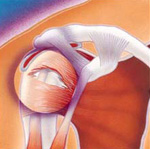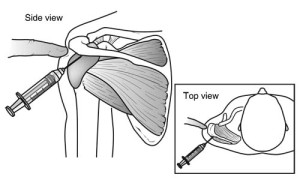Rotator Cuff Injury
Diagnosis:

Rotator cuff injuries are typically caused by a strain or tear to the muscles or tendons that make up the rotator cuff. The rotator cuff is comprised of the muscles and tendons that connect the humerus to the scapula and hold the ball-shaped head of the humerus into the shoulder socket joint. Rotator cuff injuries are quite common as a result of the wide range of motion of the shoulder joint. The pain associated with rotator cuff injuries comes from the inflammation that occurs during a sprain or tear. Inflammation can cause swelling and irritation in the muscles and tendons causing a decreased range of motion. Rotator cuff injuries have three classifications:
Grade 1 strains: Injuries in the rotator cuff occur when the fibers of the muscles or tendons are stretched beyond their capacity.
Grade 2 strains: Injuries in the rotator cuff occur when the fibers of the muscles or tendons are strained too far and partially tear.
Grade 3 strains: Injuries in the rotator cuff occur when the fibers of the muscles or tendons completely tear.
Rotator cuff injuries can develop from numerous causes including:
- Repetitive actions: Baseball pitchers and painters can develop chronic tears from overworking their rotator cuff.
- Over the head activities: Activities such as climbing a tree or reaching items on a tall shelf can cause strain or tear.
- Acute injuries: Injuries from car accidents, weight-lifting accidents or a sudden fall.
- Tendinitis: Chronic inflammation of the tendon can lead to weakening and deterioration of the rotator cuff.
Mild rotator cuff injuries will heal themselves with rest and self-care. However, moderate to severe injuries may require one or several treatment options.

Treatment Options:
Genesis Orthopedics & Sports Medicine uses cortisone injections for reducing pain and inflammation for an array of joint injuries. In certain injuries that are solely inflammation based, such as tendonitis, cortisone injections can act as a cure but with injuries that involve tearing of ligaments, cortisone injections are used for long term inflammation reduction. For AC joint sprain, cortisone is injected into the joint to reduce pain and swelling. If more than one cortisone shots does not ease the inflammation and pain, surgery may be necessary.
Physical Therapy
Consult Genesis Orthopedics & Sports Medicine for a recommended physical therapy plan. Therapy is conducted with the goal of decreasing the pain associated with AC joint sprain, restore the shoulder’s range of motion, and help it gradually regain strength.
Surgery
Distal clavicle excision is a procedure associated with complications from bursitis and bone spurs, impingement syndrome, or AC joint injury. In the instance of injury to the AC joint some of the bone is removed from the end of the clavicle to create space, while maintaining the integrity of the ligaments surrounding it. Therefore, once healed, the shoulder should regain its strength and full range of motion. The highly trained surgeons at Genesis Orthopedics & Sports Medicine can perform this procedure if deemed crucial.


